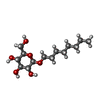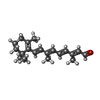+ データを開く
データを開く
- 基本情報
基本情報
| 登録情報 | データベース: PDB / ID: 9h20 | |||||||||
|---|---|---|---|---|---|---|---|---|---|---|
| タイトル | Continuous dark state structure of Sensory Rhodopsin II solved by serial millisecond crystallography | |||||||||
 要素 要素 | Sensory rhodopsin-2 | |||||||||
 キーワード キーワード | SIGNALING PROTEIN / SRII / serial millisecond crystallography / sensory rhodopsin / sensory rhodopsin II / SMX / SSX | |||||||||
| 機能・相同性 |  機能・相同性情報 機能・相同性情報monoatomic ion channel activity / photoreceptor activity / phototransduction / plasma membrane 類似検索 - 分子機能 | |||||||||
| 生物種 |  Natronomonas pharaonis (古細菌) Natronomonas pharaonis (古細菌) | |||||||||
| 手法 |  X線回折 / X線回折 /  シンクロトロン / シンクロトロン /  分子置換 / 解像度: 2.2 Å 分子置換 / 解像度: 2.2 Å | |||||||||
 データ登録者 データ登録者 | Ortolani, G. / Bosman, R. / Branden, G. / Neutze, R. | |||||||||
| 資金援助 | European Union, 1件
| |||||||||
 引用 引用 |  ジャーナル: Nat Commun / 年: 2025 ジャーナル: Nat Commun / 年: 2025タイトル: Structural basis for the prolonged photocycle of sensory rhodopsin II revealed by serial synchrotron crystallography. 著者: Bosman, R. / Ortolani, G. / Ghosh, S. / James, D. / Norder, P. / Hammarin, G. / Ulfarsdottir, T.B. / Ostojic, L. / Weinert, T. / Dworkowski, F. / Tomizaki, T. / Standfuss, J. / Branden, G. / Neutze, R. | |||||||||
| 履歴 |
|
- 構造の表示
構造の表示
| 構造ビューア | 分子:  Molmil Molmil Jmol/JSmol Jmol/JSmol |
|---|
- ダウンロードとリンク
ダウンロードとリンク
- ダウンロード
ダウンロード
| PDBx/mmCIF形式 |  9h20.cif.gz 9h20.cif.gz | 72.6 KB | 表示 |  PDBx/mmCIF形式 PDBx/mmCIF形式 |
|---|---|---|---|---|
| PDB形式 |  pdb9h20.ent.gz pdb9h20.ent.gz | 47 KB | 表示 |  PDB形式 PDB形式 |
| PDBx/mmJSON形式 |  9h20.json.gz 9h20.json.gz | ツリー表示 |  PDBx/mmJSON形式 PDBx/mmJSON形式 | |
| その他 |  その他のダウンロード その他のダウンロード |
-検証レポート
| 文書・要旨 |  9h20_validation.pdf.gz 9h20_validation.pdf.gz | 2.8 MB | 表示 |  wwPDB検証レポート wwPDB検証レポート |
|---|---|---|---|---|
| 文書・詳細版 |  9h20_full_validation.pdf.gz 9h20_full_validation.pdf.gz | 2.8 MB | 表示 | |
| XML形式データ |  9h20_validation.xml.gz 9h20_validation.xml.gz | 14.7 KB | 表示 | |
| CIF形式データ |  9h20_validation.cif.gz 9h20_validation.cif.gz | 18.2 KB | 表示 | |
| アーカイブディレクトリ |  https://data.pdbj.org/pub/pdb/validation_reports/h2/9h20 https://data.pdbj.org/pub/pdb/validation_reports/h2/9h20 ftp://data.pdbj.org/pub/pdb/validation_reports/h2/9h20 ftp://data.pdbj.org/pub/pdb/validation_reports/h2/9h20 | HTTPS FTP |
-関連構造データ
- リンク
リンク
- 集合体
集合体
| 登録構造単位 | 
| ||||||||||||
|---|---|---|---|---|---|---|---|---|---|---|---|---|---|
| 1 |
| ||||||||||||
| 単位格子 |
| ||||||||||||
| Components on special symmetry positions |
|
- 要素
要素
-タンパク質 / 糖 , 2種, 9分子 A

| #1: タンパク質 | 分子量: 26666.137 Da / 分子数: 1 / 由来タイプ: 組換発現 / 詳細: Sensory rhodopsin II, transmembrane protein / 由来: (組換発現)  Natronomonas pharaonis (古細菌) / 遺伝子: sop2, sopII / 発現宿主: Natronomonas pharaonis (古細菌) / 遺伝子: sop2, sopII / 発現宿主:  |
|---|---|
| #4: 糖 | ChemComp-BOG / |
-非ポリマー , 4種, 41分子 






| #2: 化合物 | ChemComp-RET / | ||
|---|---|---|---|
| #3: 化合物 | ChemComp-CL / | ||
| #5: 化合物 | ChemComp-MPG / [( #6: 水 | ChemComp-HOH / | |
-詳細
| 研究の焦点であるリガンドがあるか | Y |
|---|---|
| Has protein modification | Y |
-実験情報
-実験
| 実験 | 手法:  X線回折 / 使用した結晶の数: 1 X線回折 / 使用した結晶の数: 1 |
|---|
- 試料調製
試料調製
| 結晶 | マシュー密度: 2.83 Å3/Da / 溶媒含有率: 56.47 % |
|---|---|
| 結晶化 | 温度: 296 K / 手法: 脂質キュービック相法 詳細: CaCl2 150mM, Glycine 100mM, 38%(v/v) PEG 400, pH 7.5 |
-データ収集
| 回折 | 平均測定温度: 296 K / Serial crystal experiment: N |
|---|---|
| 放射光源 | 由来:  シンクロトロン / サイト: シンクロトロン / サイト:  SLS SLS  / ビームライン: X06SA / 波長: 1.0000342 Å / ビームライン: X06SA / 波長: 1.0000342 Å |
| 検出器 | タイプ: DECTRIS EIGER X 16M / 検出器: PIXEL / 日付: 2019年5月15日 |
| 放射 | プロトコル: SINGLE WAVELENGTH / 単色(M)・ラウエ(L): M / 散乱光タイプ: x-ray |
| 放射波長 | 波長: 1.0000342 Å / 相対比: 1 |
| 反射 | 解像度: 2.2→39.44 Å / Num. obs: 18087 / % possible obs: 100 % / 冗長度: 242.5 % / Biso Wilson estimate: 34.27 Å2 / CC1/2: 0.991 / Net I/σ(I): 5.6 |
| 反射 シェル | 解像度: 2.2→39.44 Å / Num. unique obs: 18087 / CC1/2: 0.991 |
- 解析
解析
| ソフトウェア |
| |||||||||||||||||||||||||||||||||||||||||||||||||
|---|---|---|---|---|---|---|---|---|---|---|---|---|---|---|---|---|---|---|---|---|---|---|---|---|---|---|---|---|---|---|---|---|---|---|---|---|---|---|---|---|---|---|---|---|---|---|---|---|---|---|
| 精密化 | 構造決定の手法:  分子置換 / 解像度: 2.2→39.44 Å / SU ML: 0.2328 / 交差検証法: FREE R-VALUE / σ(F): 1.34 / 位相誤差: 22.9155 分子置換 / 解像度: 2.2→39.44 Å / SU ML: 0.2328 / 交差検証法: FREE R-VALUE / σ(F): 1.34 / 位相誤差: 22.9155 立体化学のターゲット値: GeoStd + Monomer Library + CDL v1.2
| |||||||||||||||||||||||||||||||||||||||||||||||||
| 溶媒の処理 | 減衰半径: 0.9 Å / VDWプローブ半径: 1.1 Å / 溶媒モデル: FLAT BULK SOLVENT MODEL | |||||||||||||||||||||||||||||||||||||||||||||||||
| 原子変位パラメータ | Biso mean: 54.28 Å2 | |||||||||||||||||||||||||||||||||||||||||||||||||
| 精密化ステップ | サイクル: LAST / 解像度: 2.2→39.44 Å
| |||||||||||||||||||||||||||||||||||||||||||||||||
| 拘束条件 |
| |||||||||||||||||||||||||||||||||||||||||||||||||
| LS精密化 シェル |
|
 ムービー
ムービー コントローラー
コントローラー










 PDBj
PDBj










